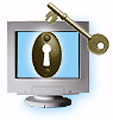|
 Turn
on your computer, and you are asked to enter a password; then you
need another one to access your Internet service; and yet another to
look up information on your favorite Web site. These days, it’s
easy to be inundated with passwords. Unlike computers where
you can add as much memory as you like, ours is limited and often
overtaxed. Turn
on your computer, and you are asked to enter a password; then you
need another one to access your Internet service; and yet another to
look up information on your favorite Web site. These days, it’s
easy to be inundated with passwords. Unlike computers where
you can add as much memory as you like, ours is limited and often
overtaxed.
The key is knowing when using
a password is really necessary. To help simplify
things, here is a quick explanation of commonly-used passwords
in Windows 98, so you can make educated decisions.
Your pass to
personalization
When several people
in a home use the same computer, Windows 98 has a useful feature
called user profiles that allows different users to maintain individual
preferences for things like screen savers, wallpaper, sound effects,
and Web favorites. Each time the computer is turned on, a password
box asks for a name and password, so Windows 98 can apply the
correct settings and to log you into your personal identity in Outlook Express.
But if you are the only person using
your computer, or if your family does not use profiles, you may find
you're still prompted for your name and password each time you log
on to Windows 98. If this is the case, entering a password to start
Windows each time you turn on your computer may be an unnecessary
step.
To simplify your logon procedure, you can eliminate the Windows
password. Here’s how to prevent Windows 98 from prompting you for a
password at startup:
1. In Control Panel, double-click
Passwords.
2. Click the Change Passwords tab, click
Change Windows Password, and then click
OK.
3. In the Change Windows Password dialog box, type your current
Windows password in the Old Password box. Leave the
New Password and Confirm New Password
boxes blank, click OK, and then click
OK.
4. Click the User Profiles tab and verify that
the "All users of this PC use the same preferences and
desktop settings" option is selected. Click
Close.
5. Shut down and then restart
Windows 98.
Increase security with a screen saver
password
Whether or not you use a Windows password,
you may want to have your computer secure if you take a break and walk away from it. Windows 98 allows you
to assign a password that is activated with your screen saver to prevent anyone
else from seeing what is on your computer, or using it while you
are away.
Normally, when you touch a key or move your mouse, the screen
saver will disappear. However when password protection is turned on,
you are asked to enter a password before you can access the
computer. If the wrong password is entered, the screen saver will
continue to cover the screen, and the keyboard can only be used to
enter the correct password.
Here’s how to
set up a screen saver password:
1. Open the Display Properties dialog box, and
select the Screen Saver tab.
2. Select the Password protected box, and then
click the Change Button.
3. Type your password, and then confirm the
password by typing it again.
Be sure to check the amount of time before
the screen saver activates. The length of time should be short enough to
protect your computer when you are away, but not so short it turns
on every time you pause to look at your notes or take a sip of
coffee.
Passwords are very important any time security
is an issue, but if you
are the only person in your house using your computer, simplify your passwords and
you may be able to get rid of a few of those
sticky-notes with cryptic words scribbled on them stuck to the edges of your
monitor. 

Mark Reed can never remember all of his
passwords.
|
Want to change your Windows
Password?
Here's how:
1. Click Start, point to
Settings, and select Control
Panel.
2. Click the Passwords icon.
3. In Password Properties, click Change
Windows Password button, and then click
OK.
4. Type your old password.
5. Type your new password, then type it again in Confirm
New Password.
Note: If you are using Windows 98 on a
network, you need to be logged on to the network to change your
Windows password. |
